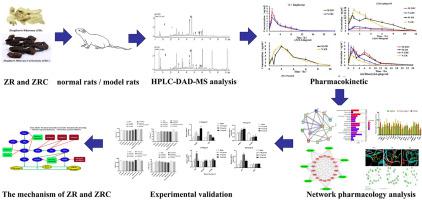Journal of Ethnopharmacology ( IF 4.8 ) Pub Date : 2022-10-01 , DOI: 10.1016/j.jep.2022.115754 Jiasheng Li 1 , Ying Zhang 2 , Shurui Liu 3 , Wangjun Li 1 , Yue Sun 1 , Hui Cao 2 , Shumei Wang 1 , Jiang Meng 1

|
Ethnopharmacological relevance
Zingiberis Rhizoma (ZR) and Zingiberis Rhizoma Carbonisata (ZRC), as two forms of ginger-based herbal drugs used in China for at least 2000 years, have been recorded in Chinese Pharmacopoeia and applied for specific indications in traditional Chinese medicine (TCM).
Aim of the study
The present study aimed to explore the underlying therapeutic and processing mechanism of the absorbed components of ZR and ZRC on deficiency-cold and hemorrhagic syndrome (DCHS) using network pharmacological technique combined with pharmacokinetics strategy.
Materials and methods
In this study, a rapid and sensitive approach was conceived to simultaneously determine the seven components (zingiberone, 6-gingerol, 8-gingerol, 6-shogaol, 6-paradol, diacetyl-6-gingerol and 10-gingerol) in rat serum by HPLC-DAD-MS. The network pharmacological technique was employed to evaluate the effect of the absorbed components of ZR and ZRC on DCHS. Also, the vitro experiments were carried out to validate the functions of the seven compounds on coagulation and other major haematological effects.
Results
The values of intra-assay and inter-assay precision were determined to be less than 7.44%, with an accuracy value ranging from 83.64% to 107.99%. Analysis of rat plasma revealed that the extraction recoveries and matrix effects of the seven analytes were >85.76%. The method for validation following oral administration of ZR and ZRC to rats was proved to be a success in the pharmacokinetic study of the seven ingredients. Pharmacokinetics showed that ZR processing could enhance the absorption and utilization of 6-shogaol, 6-paradol and diacetyl-6-gingerol, meanwhile reduce the absorption of 6-gingerol, 8-gingerol, and 10-gingerol. Through the pathway enrichment analysis, it was found that the significant biological process of ZR and ZRC on DCHS was primarily associated with complement, coagulation cascades and platelet activation pathways. The vitro experiments indicated that zingiberone, 6-paradol and diacetyl-6-gingerol had a hemostatic effect by upregulating the expression of one or more targets such as TNF-α, FⅩa, FⅫ, FⅧ, ICAM-1, vWF and ITGB3. While 6-gingerol, 6-shogaol, 8-gingerol and 10-gingerol played a critical role in promoting blood circulation by increasing the expression of TM and/or PORC, and/or reducing the expression of ITGB3.
Conclusion
In brief, network pharmacological technique in combination with pharmacokinetics strategy provided an applicable method for pharmacological mechanism study of ZR and ZRC, which, also, could be used as reference for quality control of the two drugs. In a broader sense, this combined strategy might even be valuable in uncovering the therapeutic and processing mechanism of Chinese herbs on a systematic level.











































 京公网安备 11010802027423号
京公网安备 11010802027423号